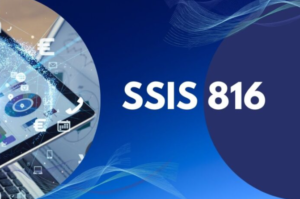Decoding SSIS 816:
At its core, SSIS stands for SQL Server Integration Services. Imagine it as a digital maestro orchestrating seamless conversations between different computer systems. Just like sharing stories with friends, SSIS ensures information flows effortlessly from one system to another.
Unveiling the Enigma: 816
What about the numbers 816? In the realm of SSIS, these digits often represent error codes or messages. Think of them as digital clues guiding us through the intricate landscape. When something unexpected occurs, it steps in to identify and rectify hiccups.
The Significance of SSIS 816 in the Technological Tapestry
Bridging the Digital Language Barrier: SSIS 816 acts as the tool that helps bridge the language gap between your system and your friend’s system. It ensures accurate information sharing, fostering seamless communication.
Unpacking the Mechanism: SSIS 816 operates like a digital chef following a recipe. It takes data from one place, transforms it (like adding chocolate chips to cookie dough), and delivers it to another destination. The 816 component identifies and rectifies any errors during this process.
Everyday Analogies: Picture your school backpack. It becomes the friend who ensures your drawing (data) safely reaches its destination without smudging or getting lost.
Mastering SSIS 816: Tips for a Smooth Journey

Stay Calm in the Digital Maze: Just as facing a tricky math problem requires composure, SSIS 816 challenges demand a calm approach. Navigate the digital maze step by step.
Mystery Behind SSIS 816 Code
-
Error Code 816:
This indicates a connectivity issue between the SSIS package and the data source. It commonly occurs when the SSIS package fails to establish a connection with the designated data source. Possible reasons include incorrect connection settings, network issues, or database configuration problems.
-
Component Not Found:
This error signifies that the SSIS runtime was unable to locate or instantiate a specific component referenced in your package. In simpler terms, it means SSIS cannot find or create a component you’ve used in your integration package.
Key Elements and Upgrades of SSIS 816
-
1. Control Flow Tasks:
Execute SQL Task: It allows you to execute SQL statements within your package. You can retrieve data, update records, or perform other database operations.
File System Task: Manage files and directories seamlessly. Move, copy, delete, or create files using SSIS 816.
Script Task: Write custom scripts (C, VB.NET, or JScript) to extend SSIS functionality.
- Data Flow Transformations:
Derived Column Transformation: Create new columns based on expressions or calculations.
Lookup Transformation: Match data from different sources using common keys.
Conditional Split Transformation: Route data based on conditions.
-
Connection Managers:
OLE DB Connection Manager: Connect to various databases (SQL Server, Oracle, MySQL, etc.).
Flat File Connection Manager: Handle flat files (CSV, TXT) effortlessly.
FTP Connection Manager: Transfer files via FTP.
-
SSIS Catalog and Deployment:
Project Deployment Model: Organize packages into projects for easier management.
Environment Variables: Configure dynamic settings based on deployment environment (dev, test, prod).
-
SSIS 816 Upgrades:
SSIS Scale Out: Distribute package execution across multiple servers for scalability.
Incremental Package Deployment: Update only changed components during deployment.
SSISDB Enhancements: Improved logging, monitoring, and execution reports.
Functional Applications and Business Advantages of SSIS 816

-
Enhanced Data Connectivity:
It seamlessly integrates with various data sources, including cloud platforms, big data repositories, and traditional databases. This broad connectivity empowers organizations to access and leverage diverse data for informed decision making.
-
Improved Performance:
SSIS 816 optimizes data loading, transformation, and extraction. Parallel processing and advanced algorithms minimize processing times, enabling efficient handling of large data volumes.
-
Advanced Debugging Tools:
Developers benefit from its advanced debugging tools and diagnostics capabilities. Real time monitoring and breakpoint debugging ensure reliable data integration workflows.
-
Scalability and Flexibility:
Whether it’s small scale projects or enterprise level data warehousing, SSIS 816 adapts to changing business needs. It grows with your organization.
Benefits of SSIS 816
Streamlined Data Integration: It consolidates data from disparate sources into a centralized repository, simplifying decision making processes.
Efficiency and Automation: It saves time by automating tasks and simplifying data organization and migration.
Scalability: It accommodates growing data volumes, ensuring flexibility as your business evolves.
Conclusion
In conclusion, SSIS 816 serves as a bridge between data realms, connecting systems, and orchestrating seamless communication. Whether you’re a tech enthusiast, a data wizard, or a curious explorer, it invites you to unravel its mysteries and embrace the ever evolving landscape of data integration. So, next time you encounter those cryptic error codes or embark on a data transformation journey, remember that it is your trusty companion—a digital maestro conducting harmonious symphonies in the world of bits and bytes.











+ There are no comments
Add yours